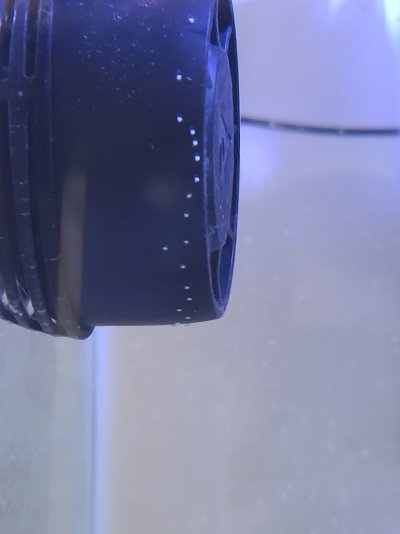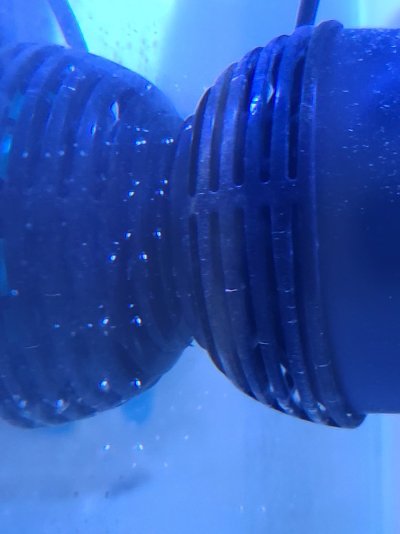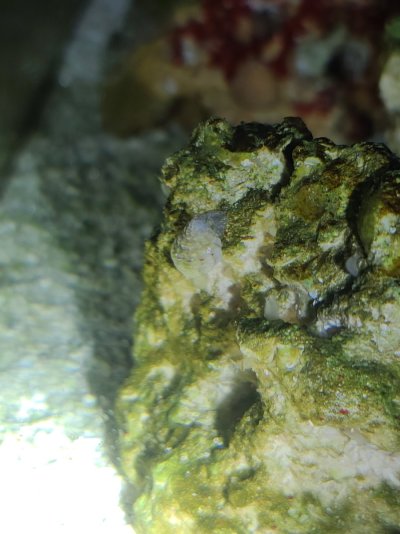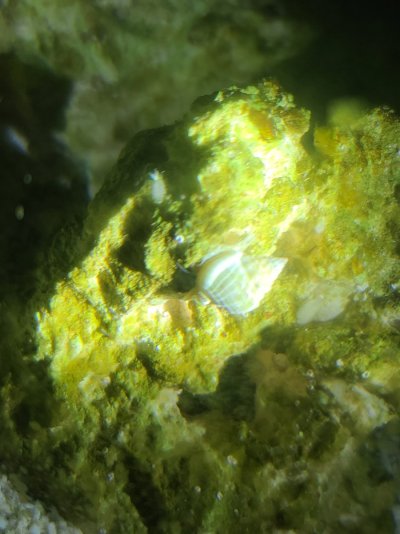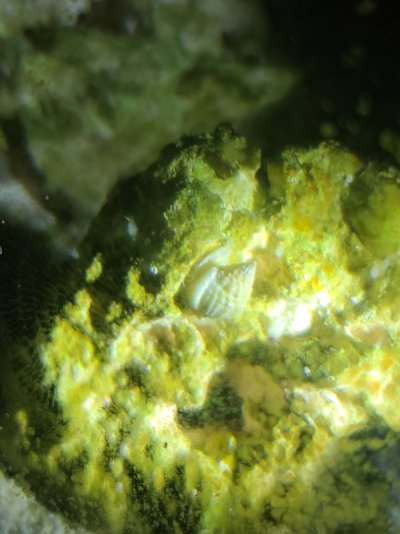I've got a small group of these around my powerhead. Smaller spheres make up the white section. Thinking they're nassarius eggs perhaps?
Navigation
Install the app
How to install the app on iOS
Follow along with the video below to see how to install our site as a web app on your home screen.
Note: This feature may not be available in some browsers.
More options
You are using an out of date browser. It may not display this or other websites correctly.
You should upgrade or use an alternative browser.
You should upgrade or use an alternative browser.
Egg sacs..
- Thread starter TokenReefer
- Start date
- Tagged users None
That sounds like a good guess.
I'll run with it! Thank you. Any idea if they can complete the life cycle in the tank? Some of the info I read says they have a 2 month planktonic period but there are so many species and others report they do reproduce successfully in aquaria...all this different info gets me confused lolThat sounds like a good guess.
If they’re Nassarius eggs then probably not, but it does seem to depend on the species (most Nassarius species I’m aware of have pelagic larvae, so they wouldn’t survive, but some - like N. fraterculus - have benthic larvae that would do just fine).I'll run with it! Thank you. Any idea if they can complete the life cycle in the tank? Some of the info I read says they have a 2 month planktonic period but there are so many species and others report they do reproduce successfully in aquaria...all this different info gets me confused lol
I'm not sure what species this is (and there are way too many species in the genus for me to feel confident in my ability to narrow the list down enough to find it), but I did find out that there are some Nassarius species (such as the Japanese Nassa, N. fraterculus) which have benthic larvae.
OP, the fact that yours are reproducing freely in a tropical tank is really cool (regardless of if they actually are Nassarius snails or not). Have they caused any issues for you, particularly with other snails, or have they just been beneficial CUC?
Also, just in case you’re curious about rearing the pelagic larvae Nassarius species:
Yeah, you probably won't see success in breeding these guys with that diet (you might, but odds are not in your favor) - various species of phytoplankton have been tried a number of times unsuccessfully in the rearing of different Nassarius species.
I know of three species of Nassarius that have been successfully aquacultured, two of which (N. vibex and N. obsoletus) were aquacultured using planktonic feeds (Phaeodactylum tricornutum and Nitzschia closterium) that were much more commonly available back in the 1900's, and the third (N. reticulatus) was cultured using a suspension feeder product called "Snow Reef" by SHG.
You can still find Phaeodactylum tricornutum available at a hefty price from UTEX, and you can find a number of Nitzschia spp. on the market too (though Nitzschia closterium is not one you'll likely find), but I'm not sure how well these feeds would work for N. distortus. Supposedly N. reticulatus may be reared exclusively on Nitzschia sp. or spp., but, to my knowledge, this hasn't been attempted again since it was first attempted back in the 1930's.
Anyway, if you're wanting to try rearing N. distortus, these foods (Phaeodactylum tricornutum, Nitzschia spp., and Snow Reef) are likely your best bets for successful rearing foods. I've heard it can take anywhere from 3-15 days for the eggs to hatch (this is likely dependent on a number of different factors), and it takes about 1-2 months for the snails to go from hatchling veligers to settled snails (the time depends on the species and the chemistry of the available substrate in your tank for certain; it likely depends on the water chemistry too, but I don't know this one for sure; it also varies from species to species, with the average time for one being 35 days, the average time for another being 45 days, etc.). So, the total rearing time for these guys is likely 1.5-2.5 months.
One important thing to keep in mind if you try rearing these guys, though, is that high algae growth in the tank may inhibit larval snail movements and result in them dying, so it may be important to keep nutrient levels/algae growth under control throughout the rearing process.
I'm not sure how long it would take for copepods to establish in the tank (it depends on a number of different factors - water chemistry, food availability, etc.).
Thank you for the responses. I believe I may have read this post as I was doing my googling earlier  . @ISpeakForTheSeas I appreciate the information you bring and share with people asking questions. I've always found both you and @Timfish to be very helpful to us new reefers
. @ISpeakForTheSeas I appreciate the information you bring and share with people asking questions. I've always found both you and @Timfish to be very helpful to us new reefers
Just going to observe. I only have a few nassarius (not sure which tbh) I got the first month the tank was up. In fact I have the original cuc minus the trochus that succumed during the Great Dino Wars. RIP (allies won btw). So if any new guys show up, I should be able to notice. I also have no wrasses right now so not much picking going on atm.
Just going to observe. I only have a few nassarius (not sure which tbh) I got the first month the tank was up. In fact I have the original cuc minus the trochus that succumed during the Great Dino Wars. RIP (allies won btw). So if any new guys show up, I should be able to notice. I also have no wrasses right now so not much picking going on atm.
Cannot be sure. The ceriths lay strings of eggs and I also have 2 big turbos but can't find any definitive pics of their eggs... my google isn't working right today lolIf they’re Nassarius eggs

I've got a small group of these around my powerhead. Smaller spheres make up the white section. Thinking they're nassarius eggs perhaps?
I never would have guessed Nassarius eggs (usually, they lay flat sheets of eggs:Cannot be sure. The ceriths lay strings of eggs and I also have 2 big turbos but can't find any definitive pics of their eggs... my google isn't working right today lol
http://melevsreef.com/pics/10/05/nassarius_snails.jpg), but looking online, it seems like some Nassarius species do lay egg sacks like these. You learn something new every day:
https://i1.wp.com/coraleverafter.org/wp-content/uploads/2021/01/IMG_0019-Medium.jpg?ssl=1&resize=697,697
Turbo snails do not deposit their eggs on hard surfaces but rather spawn by throwing their eggs and sperm into the water column:
Ahh ok. Thank you for clarifying that.Turbo snails do not deposit their eggs on hard surfaces but rather spawn by throwing their eggs and sperm into the water
Yeah most of the images I'm coming up with are the sheets. In fact this is really all I've come across so far that seems to be what I'm seeing
Nassarius Snail Eggs
So my snail has laid some eggs all over the front of my tank. (Which makes me super excited because I love Nassarius snails) but I have a few questions 1. How long before they hatch? 2. I am guessing their changes of survival? (Pretty low I am assuming) 3. Is there any way I could scrape off the...
Do you have any pictures of the Nassarius snails?Does coloration play into identifying the species or is it mainly shell shape? They look like vibex from what I can compare them to but very light colored
Different Nassarius species vary heavily in coloration (black, brown, tan, ivory), size (about a quarter of an inch to longer than an inch or so), and shell shape and texture (some are stubbier and rough while others are elongated and smooth).
Examples:
Ilyanassa obsoleta (the one that gets mixed up), has this black, stubby shell:

Nassarius shells vary, but are generally more elongated:
Tan colored Nassarius distortus:

Ivory Nassarius arcularia:

Mottled Nassarius margaritifer:
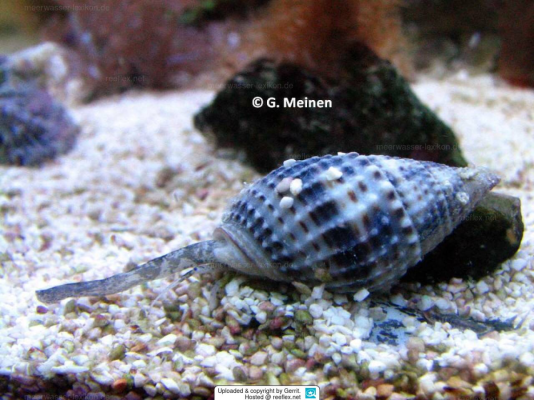
Rare Nassarius velatus (I have a single black one):
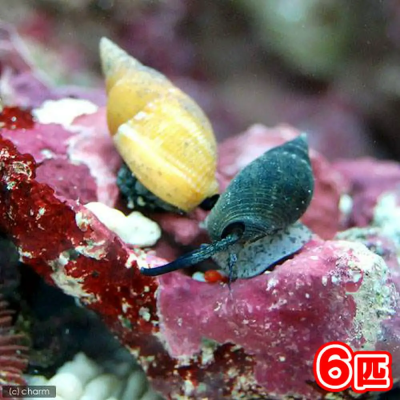
Tiny Phrontis vibex (once Nassarius vibex):

Brown Nassarius limnaeiformis:

Also avoid the Babylon snail (Babylonia sp.), sometimes sold as "Nassarius," consumes microfauna and sessile inverts:
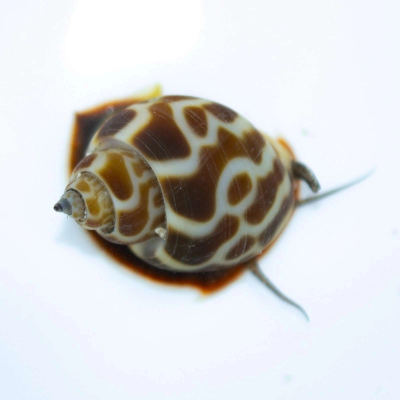
Similar threads
- Replies
- 20
- Views
- 403
New Posts
-
-
-
Favorite ATO & any other beginner equipment?
- Latest: Aquaddictorbj4
-







